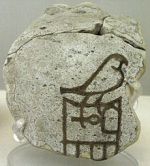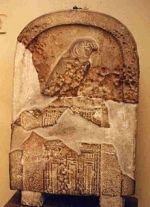ED
Here is the list of the Egyptian Dynasties and their Pharaohs (the dates vary from source to source, I am using the list as can be found in N. Grimmal’s A History of Ancient Egypt and the short descriptions are extracts from M. Rice Who’s Who in Ancient Egypt):
3150 – 2700 B.C. – The Thinite Period (aka Early Dynastic Period)
3150 – 3125 B.C. Narmer Menes:
Known as the first king to unite Upper Egypt and Lower Egypt.
Son of King Narmer. Aha’s burial at Abydos is considered the first monumental funerary complex in Egypt.
3100 – 3055 B.C. Djer
The son of Aha (?). Was the first king to be buried with sacrificed retainers (he had three hundred and seventeen buried with him).
Little is known of this king, save the elaborate tomb believed to be his located in Abydos.
3050 – 2995 B.C. Den/Udimu
Den was likely a child when he assumed the throne. During his reign, the culture and the art of Egypt flourished. In later periods it was thought that he was the author of several of the spells found in ‘The Book of the Dead’ and was also thought to have been a physician. His was the first tomb that had a granite fllor added to it – the first evidence of the use of stone in Egyptian architecture.
Merneith was the daughter of Djer, the wife of Djet and the mother of Den. It is possible that as regent, she was a ruler in her own right. She was given a great tomb in Abydos, including retainers and a barque for her to sail the skies along with the sun-god Ra.
2995 – B.C. Anedjib/Andjyab/Enezib
Little is known of this king, his reign might have been a time of unrest in Egypt. He was, however, the first ling to reside in Memphis, later one of the more celebrated cities of Egypt.
– 2950 B.C. Semerkhet
A king whose legitimacy has been questioned and who doesn’t appear in any king-lists. Very little is known of him.
2960 – 2926 B.C. Ka’a/Qa’a
The last king of Dynasty I, and though he seemed to have reigned for a long time, little is known of Ka’a. It is also unknown what brought about the end of this dynasty and the beginning of the next.
Hetepsekhemwy was the first king of the second dynasty. His name means ‘The Two Powers are at Peace’ this might indicate that he came to the throne after a time of unrest, again unifying the two Egypts.
Reneb little is known of this king, though he is the first king whose name includes that of the sun-god Ra. He was likely buried in Saqqara, though his tomb was never found.
Nynetijer/Nutjeren ruled for a considerable time, and though he is largely unknown, some incidents related to his time are recorded in the Palermo Stone. During his reign there was extensive building, and his was likely to have been buried in Saqarra though his tomb has not been found.
Weneg an obscure king who is known only because a bowl containing his name was found under the Step Pyramid complex. It is possible that his power was limited to the Memphis area.
Sened an obscure king of the second dynasty who would have remained unknown if not for the inscription found on the wall of the tomb of Sheri, a fourth dynasty funerary priest. That Sened’s funerary cult was still operating in the fourth dynasty suggests that he had some status among the kings of Egypt.
 Peribsen was the first king to associate himself with the hound (?)-god Seth instead of the falcon-god Horus making his name Seth-Peribsen. There was unrest in Egypt during his reign, which eventually led to the fall of the second dynasty. His funerary cult continues to the fourth dynasty indicating that his memory was honoured ling after his death.
Peribsen was the first king to associate himself with the hound (?)-god Seth instead of the falcon-god Horus making his name Seth-Peribsen. There was unrest in Egypt during his reign, which eventually led to the fall of the second dynasty. His funerary cult continues to the fourth dynasty indicating that his memory was honoured ling after his death.
Sekhemib a king so obscure that some claim that this person is the same as Seth-Peribsen, though some believe that he was a king who ruled Lower Egypt at the same time that Peribsen ruled Upper Egypt.
Khasekhem/Khasekhemwy was one of the greatest kings of Egypt. His name means ‘In Him the Two Powers are at Peace’, he was one of Egypt’s true unifiers. He was unique because he adopted the dual serakh with both Horus and Seth. his reign was long and saw a great advancement in culture and architecture. He was buried in Abydos.












Nov 06, 2013 @ 22:39:32
i love all god and goddess